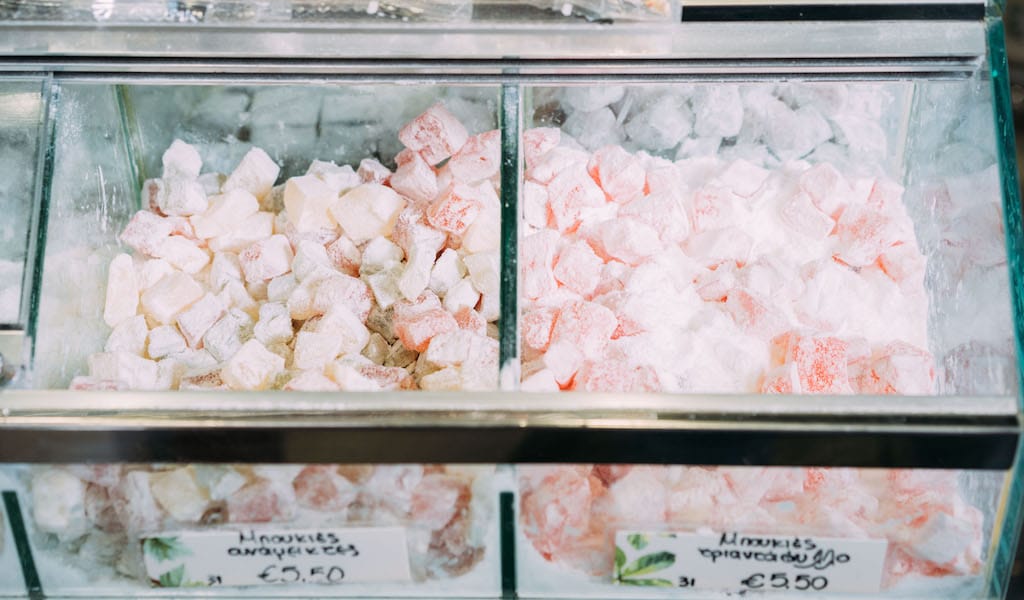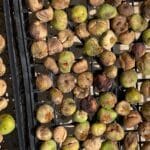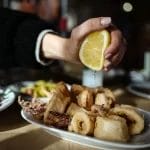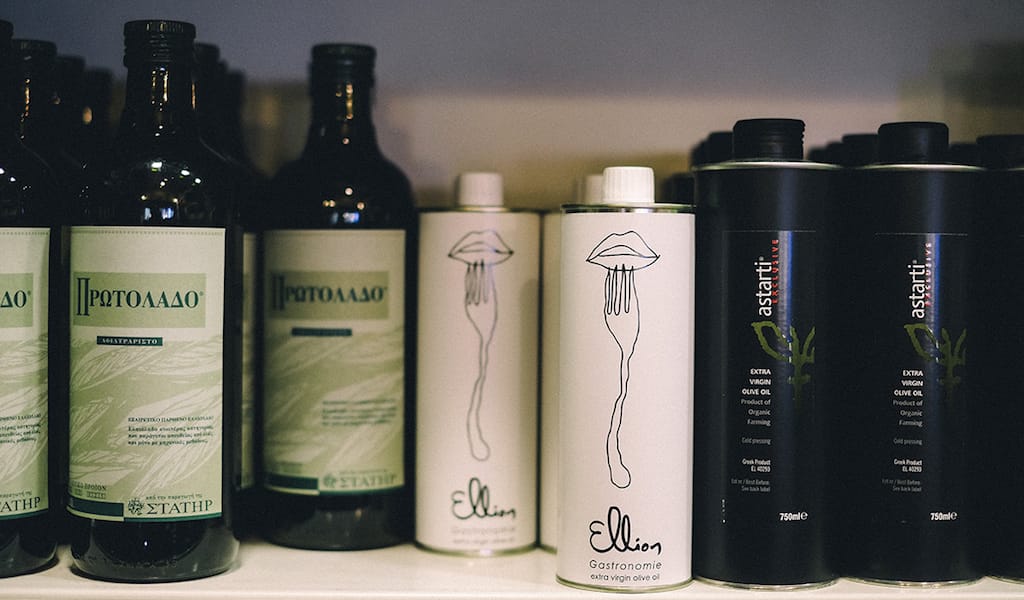It used to be that when you paid an unexpected visit to a Greek household, you would almost surely be offered a gelatinous and aromatic sweet called loukoumi – a little pillowy bite covered in powdered sugar. Likewise, a coffee at kafeneia, Greek coffee shops, used to be accompanied by a loukoumi, as the sugary treat complimented the dark brew.
While loukoumi is not as commonplace nowadays, it is still a beloved treat in Greek homes, for it’s sweet enough to satisfy sugar cravings, but simple enough – the basic ingredients are water, sugar and starch – to be relatively low-calorie. And even if it’s not as popular as it used to be, it has certainly had a lasting impact: consider that the word “loukoumi” is used in the Greek language to mean something delicious in general, whether a nicely roasted piece of meat, a coveted object or a beautiful woman.
There are several different theories on how loukoumi was first created, but the origin of the confection is not well established. The most popular version holds that Haci Bekir concocted the recipe for lokum, as it’s called in Turkish, in 1777 in Istanbul using cornflour and the newly available refined beet sugar to develop a chewy, sweet, jelly-like candy.
To this day, Haci Bekir is still one of the most famous purveyors of lokum in Istanbul, making this story sound a bit too pat. According to the Ottoman food historian Priscilla Mary Işın, author of Sherbet and Spice: The Complete Story of Turkish Sweets and Desserts and the more recent title Bountiful Empire: A History of Ottoman Cuisine, confectioners at the Ottoman palace developed lokum as we know it today. “The document I found shows that in the late 18th century there was an attempt to forbid city confectioners from producing lokum, because it was a specialty of the palace confectioners,” she told us.
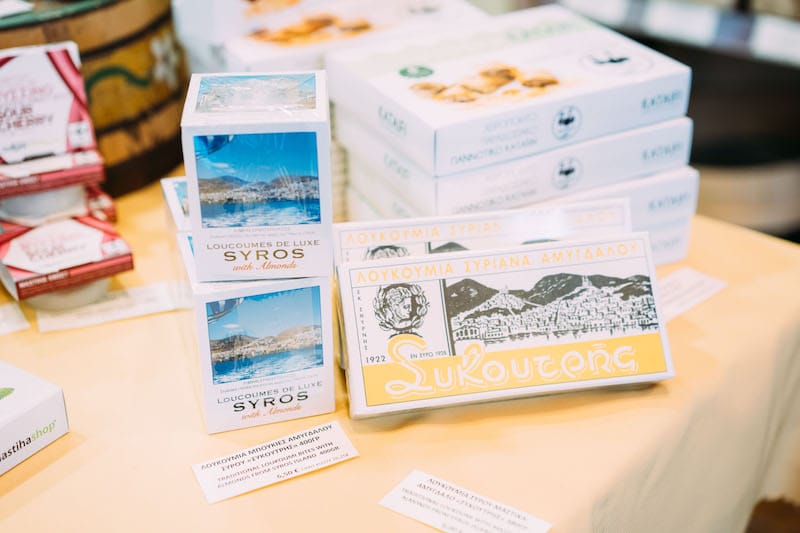
“Lokum arose as a sophisticated version of a starch pudding called pelte, from the Persian palude, which originated in Persia and became popular with the Ottomans, who developed their own variations,” she continued. “In the 17th century the religious scholar, poet and gourmet Nev’îzâde Atâî presented his version of pelte to the palace. His pelte was made with white sugar, wheat starch and rose water, and stirred unceasingly for three hours. The stirring process became a key part of lokum making and so this version can be regarded as the prototype of real lokum as it was developed at the palace.”
Loukoumi traveled from Ottoman Istanbul to Greece sometime in the early 19th century and very quickly became an important part of Greek gastronomic and social culture. Although produced all over the country, the most famous loukoumia (the plural of loukoumi) are undoubtedly those from the island of Syros, the capital of the Cyclades. (It’s said that the superior taste of Syros’ loukoumia is partly a result of the natural, brackish water sourced from the island’s mountainous areas.)
According to Dina Sikoutris, the owner of a traditional loukoumi workshop in Syros and a loukoumi history buff, the recipe for the sweet traveled with refugees from Chios to Ermoupolis in Syros sometime around 1824, during the Greek War of Independence. They were fleeing political unrest at home, which at that time was an affluent island with merchants and shipowners, and famous for its orchards, rose bushes and the production of mastic, the fragrant resin used in cosmetics, medicine and foodstuffs. So these refugees brought with them not only the recipe for this tasty sweet treat, but also the flavors of their home, i.e. loukoumi flavored with mastic and rosewater.
“Making loukoumi is simple but tricky. Like all traditional crafts, it requires expertise.”
The first mention of loukoumi production on Syros dates to 1832, and gradually some 30 workshops were established. Loukoumi was the one of the first exports of the newly minted Greek state, and loukoumia from Syros quickly found their way into royal houses all over Europe and were sent as far as Japan. At the beginning of the 20th century, Syros was exporting around seven to eight tons of loukoumi annually.
Their ease of transport, relatively low price and attractive packaging made them coveted souvenirs. Every time a ship stopped at Syros port, loukoumi vendors would storm the vessel holding large baskets full of colorful boxes, loudly advertising their products to passengers.
Loukoumi, however, never became a luxury item, available only to a few. They were often included in the lunch pails of workers, who would make a sandwich of loukoumi and sesame koulouri. To this day, they play an important role in weddings, funerals and memorial services on the island.
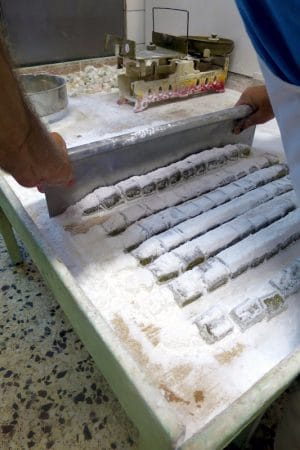 Only a few loukoumi producers remain on Syros today (Leivadaras, Korres, Denaxas, Sikoutris, Xagoraris and Kanakaris), and only one – Sikoutris – still does everything by hand. We visited their traditional workshop to watch the production process, which involves stirring the three main ingredients – water, sugar and starch – as they boil in large copper cauldrons. Once thickened, aromatics like bergamot, mastic, rose, honey, natural coloring and nuts are added, depending on the recipe.
Only a few loukoumi producers remain on Syros today (Leivadaras, Korres, Denaxas, Sikoutris, Xagoraris and Kanakaris), and only one – Sikoutris – still does everything by hand. We visited their traditional workshop to watch the production process, which involves stirring the three main ingredients – water, sugar and starch – as they boil in large copper cauldrons. Once thickened, aromatics like bergamot, mastic, rose, honey, natural coloring and nuts are added, depending on the recipe.
Aggeliki Andriomenou, the third generation of the Sikoutris family to run the workshop, explained that “making loukoumi is simple but tricky. Like all traditional crafts it requires expertise as to when the mixture is ready to be poured into the wooden molds because no thermometers are used.” The wooden molds are lined with flour and the mixture stays there for a day, or a day and a half on humid days, until it sets. Then the loukoumi maker will place the large slabs onto a surface dusted with a good amount of powdered sugar and cut them into various sizes.
“We [like most producers from Syros] don’t use any glucose syrup, dextrose or gelatin for our loukoumia and no artificial flavorings… We bring the rose petals from Chios too to make rose sugar, which is then used to flavor loukoumia. Most nuts are Greek, unless there is a shortage, and the honey comes from Crete,” said Aggeliki.
Despite the renown of the soft and delicate loukoumia from Syros, there are many other varieties and delicious types of this sweet treat. A number of producers, like Organic Islands on Naxos and Citrus on Chios, are moving away from traditional flavors and instead making loukoumia flavored with herbs like lavender and rosemary or fruits like mandarin oranges and figs.
We should also mention three other types of loukoumi that are prominent on the mainland. There’s moustoloukouma, a type of loukoumi made with grape must, which produces a caramelized aroma, and typically found in Volos, a seaside town in central Greece.
Another is akanes, a rare treat found in the northern Greek city of Serres (production began here in 1927, when refugees from Asia Minor settled in the city). It looks like loukoumi but is much chewier, with the distinct taste of butter and the crunch of roasted almonds, which are hidden in its core. The main difference between the two is that akanedes are not cut by hand – they are instead poured into semi-spherical bite-sized molds brushed with goat milk (or buffalo milk) butter.
Finally, there’s soutzouk loukoum, from Komotini. It looks like a sausage (hence the name soutzouk from the Turkish sucuk, which means sausage) and is usually made with grape must and nuts, although nowadays it comes in many different flavors. It is made by stringing walnuts on a long thread, which is then dipped twice into the loukoumi mixture and hung to dry. Once the “sausage” is set, the outside is dusted with sugar to further make it look like cured meat.
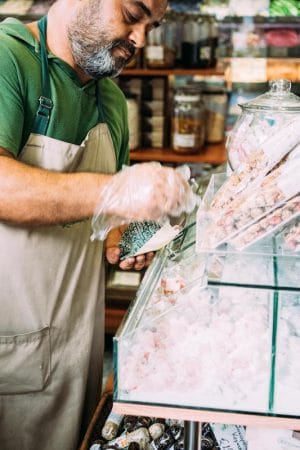 In a perfect world, you could buy your loukoumi in the area where it is produced and eat it fresh. However, knowing that this is not always possible, here’s a small list of shops in Athens that carry different types of loukoumi, as well as other delicious products.
In a perfect world, you could buy your loukoumi in the area where it is produced and eat it fresh. However, knowing that this is not always possible, here’s a small list of shops in Athens that carry different types of loukoumi, as well as other delicious products.
Pantopoleion Mesogeiakis Diatrofis
Pantopoleion was one of the first more upmarket bakalika that opened in Athens in 2005. They have an impressive selection of foodstuffs from all over Greece, all of them packaged. As far as loukoumia are concerned, they stock those made by Sikoutris in Syros and Mediterra in Chios, and the grape-must loukoumi from Volos produced by a small workshop called Pappous.
Kolios
Kolios is a treasure trove of Greek products, with a large variety of honeys available to taste and buy, as well as a curated selection of Greek products from all over the country. Here you will find loukoumi from the island of Icaria, made by Glyka Teskou, a small, family-run business, which is available for purchase by the kilo.
1001 Gefseis
Specializing in nuts of all kinds this shop in the heart of Varvakeios also stocks the hard-to-find soutzouk loukoum and akanes together with loukoumi made by Leivadaras in Syros. They also make very tasty nut butters.
Yoleni’s
Located in the heart of Kolonaki, Athens’ upmarket neighborhood, this multistory Greek delicatessen not only stocks delicious goodies from small producers nationwide that you can buy packaged or by the kilo, but also has a restaurant, a wine cellar and an olive oil bar. They carry the delicious loukoumi from Chios made by Citrus as well as loukoumi made by Organic Islands in Naxos. You can also shop online at www.yolenis.com.
Mandragoras
For anyone traveling to or from Piraeus port, Mandragoras is a must-stop. What began as a spice emporium in 1955 has now morphed into a bakaliko stocking anything from rare Greek cheeses to honeys and jarred treats. They also offer one of the greatest selections of Greek dried oregano from the country’s mountains. With such a wide range of products, it’s no surprise that they also sell loukoumi, specifically those made by Korres in Syros, Pappous in Volos and Tsekos in Icaria. Yet you may find others as well, since they are constantly add new products.
Editor’s note: Our recurring Building Blocks feature focuses on foods and ingredients that are fundamental to the cuisines we write about.
Published on August 24, 2018
Related stories
Get the scoop on the best of the Greek pantry on our culinary walk.
August 2, 2017
AthensIn Greece, where the land is mostly rocky and steep and the climate hot and arid, the olive tree thrives, and for millennia, olive oil has been as essential to Greek cooking as the gnarled, silver-leaved trees have been to its landscape. Greece is the third largest producer of olive oil in the world after…
September 12, 2022
AthensWhoever came up with the expression “I don’t give a fig” had obviously never tasted a Greek fig fresh off the tree. How figs, almost certainly dried, came to be considered common and worthless in late medieval England is a mystery, but for the Greeks, they have always been something to treasure and preserve, to…
March 16, 2022
AthensQuick Bite: On this afternoon food tour of Exarchia, we’ll explore this vibrant neighborhood’s roots in political activism but also investigate why it is also home to some of the city's best eats. This 6-hour tour includes more than a dozen essential bites, sips and stops that illustrate the history and culture of this iconic…







































